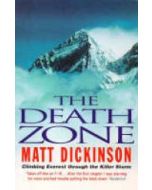We use cookies to make your experience better. To comply with the new e-Privacy directive, we need to ask for your consent to set the cookies. Learn more
A Day to Die For
1996: Everest's Worst Disaster
£10.99
In Stock
Usually dispatched within 24 hrs. Free delivery to UK for orders £25 and over
| Cordee Code: | CPB145 |
|---|---|
| Page Size: | 126 x 129 mm |
| No of Pages: | 334 |
| Publisher: | Mainstream Publishing |
| ISBN13: | 9781780576411 |
| Author: | Graham Ratcliffe |
| Published Date: | May 2013 |
| Edition: | PB edn May 2013 |
| Binding: | Paperback |
| Illustrations: | B+W photos |
| Weight: | 260g |
| Geoarea: | Himalaya |
| Product Type: | Book |
| Countries: | China |
On the night of 10-11 May 1996, eight climbers perished in what remains the worst disaster in Everest's history. Following the tragedy, numerous accounts were published, with Jon Krakauer's Into Thin Air becoming an international bestseller. But has the whole story been told?
A Day to Die For reveals for the first time the full, startling facts that led to the tragedy. Graham Ratcliffe, the first British climber to reach the summit of Mount Everest twice, was a first-hand witness, having spent the night on Everest's South Col at 26,000 ft, sheltering from the deadly storm. For years, he has shouldered a burden of guilt, feeling that he and his teammates could have saved lives that fateful night. His quest for answers has led to discoveries so important to an understanding of the disaster that he now questions why these facts were not made public sooner. History is dotted with highprofile disasters that both horrify and capture the attention of the public, but very rarely is our view of them revised to such devastating effect.
A Day to Die For reveals for the first time the full, startling facts that led to the tragedy. Graham Ratcliffe, the first British climber to reach the summit of Mount Everest twice, was a first-hand witness, having spent the night on Everest's South Col at 26,000 ft, sheltering from the deadly storm. For years, he has shouldered a burden of guilt, feeling that he and his teammates could have saved lives that fateful night. His quest for answers has led to discoveries so important to an understanding of the disaster that he now questions why these facts were not made public sooner. History is dotted with highprofile disasters that both horrify and capture the attention of the public, but very rarely is our view of them revised to such devastating effect.



